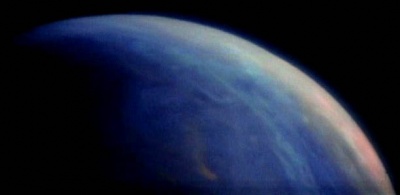Class O
Class O, or "Pelagic" planets, are similar to Class M worlds but over 80% of their surface is covered in water. Life forms would mainly be aquatic in nature. Argo and Pacifica are considered Class O planets.
To better understand the nature of a Class O planet, it is important to discuss the different layers of the planets aquatic zones:
Any water in the sea that is not close to the bottom is in the pelagic zone. The word pelagic comes from the Greek πέλαγος or pélagos, which means open sea.
It can be thought of in terms of an imaginary cylinder or water column that goes from the surface of the sea almost to the bottom, like the diagram on the left. Conditions change as you go deeper down the water column; the pressure increases and there is less light. Depending on the depth, scientists further subdivide the water column, rather like the earth's atmosphere is divided into different layers.
Description[edit]
The on average pelagic zone occupies 1,370 million cubic kilometres (330 million cubic miles) and has a vertical range up to 11 kilometres (6.8 miles). animals that live in the pelagic zone are called pelagic life. Pelagic life decreases with increasing depth. It is affected by light levels, pressure, temperature, salinity, the supply of dissolved oxygen and nutrients, and the submarine topography.
In deep water the pelagic zone is sometimes called the open-ocean zone and can be contrasted with water that is near a coast or on a continental shelf. However in other contexts, coastal water that is not near the bottom is still said to be in the pelagic zone.
The pelagic zone can be contrasted with the benthic and demersal zones at the bottom of the sea. The benthic zone is the ecological region at the very bottom of the sea. It includes the sediment surface and some sub-surface layers. Marine organisms living in this zone are called benthos. The demersal zone is just above the benthic zone. It can be significantly affected by the seabed and the life that lives there. Animals that live in the demersal zone are called demersal life.
Depth and layers[edit]
Depending on how deep the sea is, there can be up to five vertical layers in an ocean. From the top down, they are:
Epipelagic (sunlit)[edit]
- From the surface (MSL) down to around 200 m (656 ft).
The illuminated surface zone where there is enough light for photosynthesis. Due to this, plants and animals are largely concentrated in this zone. Nearly all primary production in the ocean occurs here. This layer is the domain of most vertibrate and invertebrate lifeforms. Additionally most Sentient Aquatic lifeforms evolve within this zone.
Mesopelagic (twilight)[edit]
:From 200 m down to around 1,000 m (3,280 ft).
Although some light penetrates this deep, it is insufficient for photosynthesis. The name stems from Greek μέσον, middle. At about 500 m the water becomes depleted of oxygen. Still, an abundance of life copes with more efficient gills or minimal movement. Animals such as semi-deep-sea creatures live here.
Bathypelagic (dark)[edit]
- From 1,000 m down to around 4,000 m (13,123 ft).
By this depth the ocean is almost entirely dark (with only the occasional thermoluminescence organism). There are no living plants, and most animals survive by consuming the snow of detritus falling from the zones above or by preying upon others. From Greek βαθύς (bathýs), deep
Abyssopelagic[edit]
- From 4,000 m down to above the ocean floor.
No light whatsoever penetrates to this depth. The name is derived from the Greek ἄβυσσος (ábyssos), abyss, meaning bottomless (a holdover from the times when the deep ocean was believed to be bottomless).
Hadopelagic[edit]
- The deep water in ocean trenches.
The name is derived from the Greek Ἁΐδης (Haidēs), Hades, the classical Greek underworld. This zone is mostly unknown, and very few species are known to live here (in the open areas). However, many organisms live in hydrothermal vents in this and other zones. Some define the hadopelagic as waters below 6,000 m (19,685 ft), whether in a trench or not.
The bathypelagic, abyssopelagic, and hadopelagic zones are very similar in character, and some marine biologists combine them into a single zone or consider the latter two to be the same.
